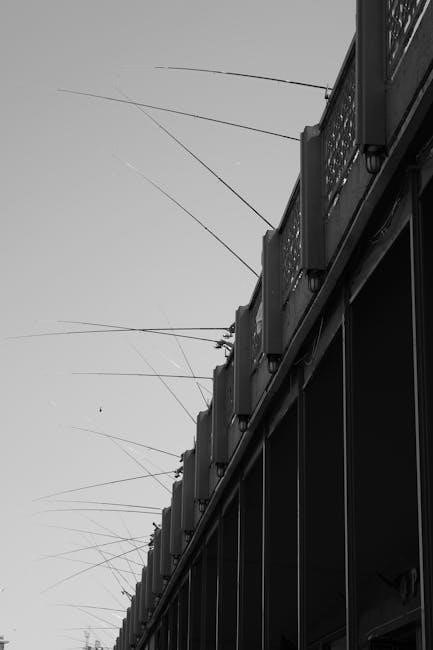Replacing fishing rod guides is a common task for anglers‚ ensuring optimal performance and preventing further damage. Guides are crucial for line control and sensitivity‚ making replacement essential when damaged or worn; Proper installation is key to maintaining rod balance and effectiveness‚ whether on the water or in the shop.
1.1 Overview of Fishing Rod Guides
Fishing rod guides are circular or oval rings attached along the rod’s length‚ guiding the fishing line and improving casting accuracy. Made from materials like ceramic or stainless steel‚ they reduce line wear and friction. Properly aligned guides enhance sensitivity and control‚ while poorly maintained ones can damage the line or affect performance. They are securely fastened to the rod blank using epoxy or thread wraps‚ ensuring durability. Regular inspections and maintenance are crucial to extend their lifespan and maintain optimal fishing efficiency.
1.2 Reasons for Replacing Guides
Guides may need replacement due to damage from accidents‚ rough handling‚ or normal wear and tear. Broken rings‚ corrosion‚ or loose fastenings can impair fishing performance. Over time‚ guides can become worn‚ causing line friction and potentially leading to breakage. Additionally‚ exposure to harsh environmental conditions‚ such as saltwater or extreme temperatures‚ can degrade guide materials. Replacing damaged or worn-out guides ensures smooth line flow‚ maintains rod sensitivity‚ and prevents further damage to the rod or line during use.
1.3 Tools and Materials Needed
To replace fishing rod guides‚ you’ll need specific tools and materials. A razor blade or cutting tool is essential for removing old guides and epoxy. Epoxy resin and a small paintbrush are necessary for securing new guides. Additionally‚ winding thread and a bobbin are required for wrapping and finishing. Other useful tools include a hair dryer or heat source to soften old adhesive and a cleaning cloth to prepare the rod blank. Having these items ready ensures a smooth and professional replacement process.
Understanding the Importance of Fishing Rod Guides
Fishing rod guides are essential for line control and sensitivity‚ directly impacting casting distance and accuracy. They enhance the overall fishing experience by managing line effectively.
2.1 Types of Fishing Rod Guides
Fishing rod guides come in various types‚ each designed for specific fishing needs. Ceramic guides are popular for their smooth‚ line-protecting rings and durability. Stainless steel guides offer exceptional strength and resistance to corrosion‚ making them ideal for saltwater use. Roller guides are specialized for trolling and heavy-duty fishing‚ reducing line wear and friction. Each type serves a unique purpose‚ ensuring anglers can choose the best option for their fishing style and conditions to enhance performance and longevity of their gear.
2.2 Impact of Guides on Fishing Performance
Fishing rod guides significantly influence performance by enhancing casting distance‚ accuracy‚ and line control. Quality guides reduce line friction‚ preventing wear and tear‚ while ensuring sensitivity for detecting bites. Properly functioning guides improve balance and reduce fatigue during long fishing sessions. Damaged or poorly maintained guides can lead to line tangles‚ reduced casting efficiency‚ and decreased overall performance‚ making regular maintenance and timely replacement crucial for optimal fishing experiences and successful angling outcomes.
2.3 Signs That Guides Need Replacement
Signs that fishing rod guides need replacement include visible damage such as cracks‚ nicks‚ or broken rings. If guides are loose‚ misaligned‚ or show excessive wear‚ they should be replaced. Line tangling‚ uneven stress distribution‚ or reduced casting accuracy are also indicators. Additionally‚ if guides are corroded or show signs of UV damage‚ replacement is necessary to maintain performance and prevent further rod damage. Addressing these issues promptly ensures optimal fishing efficiency and extends the life of the rod.
Types of Fishing Rod Guides

Fishing rod guides come in various materials‚ including ceramic‚ stainless steel‚ and roller guides‚ each offering unique benefits for different fishing applications and rod types.
3.1 Ceramic Guides
Ceramic guides are highly durable and offer a smooth surface‚ reducing line wear and tear. They are ideal for light to medium action rods‚ providing excellent line control and sensitivity. Ceramic guides are resistant to corrosion and abrasion‚ making them a popular choice for freshwater and saltwater fishing. Their smooth rings minimize friction‚ allowing the line to flow freely‚ which is especially beneficial for delicate presentations. Anglers often prefer ceramic guides for species like trout or panfish‚ where finesse and precision are key. They are lightweight yet robust‚ ensuring long-lasting performance.
3.2 Stainless Steel Guides
Stainless steel guides are highly durable and resistant to corrosion‚ making them ideal for saltwater fishing. They are heavier than ceramic guides but offer exceptional strength and resistance to wear. Stainless steel guides are a popular choice for heavy-duty applications and larger fish species. They are often used on baitcasting and trolling rods due to their ability to withstand harsh conditions. While they may lack the smoothness of ceramic guides‚ their longevity and reliability make them a practical option for anglers seeking durability in challenging environments. Regular cleaning and maintenance ensure optimal performance.

3.3 Roller Guides
Roller guides are designed to reduce line wear and friction‚ especially during intense battles with large fish. They feature a rotating ring that allows the line to move smoothly‚ minimizing stress on the rod. These guides are particularly useful for trolling and deep-sea fishing‚ where drag systems are heavily engaged. Roller guides are durable and resistant to corrosion‚ making them a favorite among serious anglers. They are typically more expensive than ceramic or stainless steel guides but provide unparalleled performance in demanding conditions. Regular maintenance ensures optimal functionality and longevity.

Tools and Materials Needed for Replacement
Essential tools include a razor blade‚ cutting tool‚ hair dryer‚ or heat gun for removing old guides. Epoxy‚ thread‚ and a small paintbrush are also necessary for installation.
4.1 Essential Tools for the Job
Replacing fishing rod guides requires specific tools for a successful process. A razor blade or cutting tool is necessary for removing old guides and scraping off epoxy. A hair dryer or heat gun can soften old adhesive‚ making removal easier. Epoxy resin and thread are essential for securing the new guide. A small paintbrush helps apply epoxy evenly. Other useful items include a wire cutter‚ sandpaper for smoothing the rod blank‚ and a ruler for accurate guide placement. Having these tools organized ensures a precise and efficient replacement process.
4.2 Materials Required for Installation
Key materials for installing new fishing rod guides include high-quality epoxy resin‚ durable threading material‚ and the replacement guides themselves. Ceramic or stainless steel guides are popular choices‚ offering durability and smooth line flow. Fuji guides are a preferred option among anglers for their reliability. Additionally‚ a small amount of UV-cured glue or epoxy can be used to secure the thread wraps. Ensure the materials match your rod’s specifications for optimal performance and longevity. Using the right materials guarantees a professional-grade installation and enhances your fishing experience.

Step-by-Step Guide to Replacing Fishing Rod Guides

Replace guides by removing the old ones with a razor blade‚ scraping off epoxy‚ and installing new guides. Secure with epoxy‚ ensuring proper alignment for optimal performance.
5.1 Removing the Old Guide
Start by cutting the epoxy and thread wrapping around the old guide using a razor blade. Gently twist the guide back and forth while pulling upward to remove it. Once detached‚ scrape off remaining epoxy and thread residue from the rod blank. This ensures a clean surface for the new guide installation. Be careful to avoid damaging the rod blank during the process. Proper removal is crucial for a successful replacement and optimal performance of your fishing rod.
5.2 Preparing the Rod Blank
After removing the old guide‚ clean the rod blank thoroughly to eliminate any remaining epoxy or residue. Use a razor blade or scraper to gently remove debris‚ ensuring a smooth surface. Inspect for any nicks or scratches and smooth them out. Align the new guide with the original position for proper balance and performance. Clean the area with alcohol to remove contaminants‚ promoting better adhesion. Apply a thin layer of epoxy or adhesive‚ following the manufacturer’s instructions‚ to prepare for the new guide installation.
5.3 Installing the New Guide
Align the new guide with the rod blank‚ ensuring proper positioning. Apply a small amount of epoxy to the base of the guide and press it firmly onto the blank. Hold it in place for a few seconds to secure it. Use a heat source‚ like a hair dryer‚ to speed up the epoxy curing process. Once set‚ wrap thread around the base‚ applying a thin layer of epoxy to seal it. Finish by trimming excess thread and applying a protective finish to the wraps.

Choosing the Right Guide for Your Fishing Rod
Selecting the right guide involves considering size‚ material‚ and type to ensure optimal performance and durability. Proper alignment with the rod’s action and fishing style is crucial.
6.1 Selecting the Correct Guide Size
Choosing the right guide size involves considering the rod’s action‚ length‚ and fishing style. Use a guide spacing chart to ensure proper size and alignment. The guide’s ring diameter should match the rod blank’s thickness‚ typically smaller near the tip and larger towards the base. Proper sizing ensures smooth line flow‚ even stress distribution‚ and optimal performance‚ preventing breakage and enhancing casting accuracy. Consult manufacturer specs and consider fishing conditions and target species for the best fit.
6.2 Considering Guide Material
When selecting guide materials‚ consider durability‚ corrosion resistance‚ and line compatibility. Ceramic guides offer smoothness and reduce line wear‚ ideal for light tackle. Stainless steel guides provide strength and corrosion resistance‚ suitable for saltwater. Roller guides minimize line twist and are great for heavy lines. Choose materials based on fishing conditions and personal preference for optimal performance and longevity.

Maintenance Tips to Extend Guide Life
Regular cleaning and inspection are key to extending guide life. After each use‚ rinse guides with fresh water to remove dirt and salt residue. Use a soft cloth to wipe down the rod and guides‚ preventing moisture buildup. Store rods in a dry place‚ avoiding direct sunlight. Lubricate moving parts occasionally to maintain smooth operation. Addressing minor damage promptly prevents major issues‚ ensuring guides remain functional and reliable for future fishing trips.
Common Mistakes to Avoid During Replacement
Avoid common mistakes like using improper tools‚ which can damage the rod blank. Applying too much epoxy or failing to align guides correctly can affect performance. Overheating during removal may harm the rod‚ while improper wrapping techniques can lead to loose guides. Neglecting to cure epoxy fully results in weak bonds. Using the wrong guide size disrupts rod balance. These errors can compromise functionality‚ so attention to detail is crucial for a successful replacement.
Cost Implications of Replacing Guides
Replacing fishing rod guides can vary in cost‚ depending on guide type and brand. Individual guides range from $5 to over $20‚ while repair kits may cost $10-$30. Professional installation adds labor fees‚ increasing the total expense. High-end materials‚ like Fuji or CRB guides‚ are pricier but offer durability. DIY repairs save money but require skill. Overall‚ costs are manageable‚ but improper installation can lead to further expenses. Balancing quality and budget is key for a cost-effective solution.
Manufacturer Options for Replacement Guides
Top manufacturers like Fuji‚ CRB‚ Pacific Bay‚ REC‚ and American Tackle offer high-quality replacement guides. Fuji is renowned for its durability and performance‚ while CRB provides affordable‚ reliable options. Pacific Bay and REC are popular for their versatile designs‚ catering to both freshwater and saltwater needs. American Tackle specializes in innovative‚ lightweight guides. These brands ensure compatibility and superior performance‚ making them trusted choices for anglers. Their products are widely available online‚ allowing easy access for DIY repairs or professional installations.

When to Seek Professional Help
While replacing guides can be a DIY task‚ complex damage or high-performance rods may require professional expertise. If the guide is near the tip or the rod blank is damaged‚ a pro is recommended. Shops often have access to genuine replacement guides and can ensure precise alignment and durability. They also handle intricate repairs‚ such as rewrapping or balancing the rod. For anglers unsure of their skills or facing multiple guide replacements‚ professional help ensures a flawless‚ long-lasting result‚ preserving the rod’s performance and longevity.
Replacing fishing rod guides is a straightforward yet critical process to maintain optimal performance. Properly installed guides enhance sensitivity‚ reduce line wear‚ and improve casting accuracy. Regular inspection and timely replacements prevent costly damage. While DIY repairs are feasible‚ seeking professional help for complex issues ensures durability. By understanding the importance of guides and following best practices‚ anglers can extend their gear’s lifespan and enjoy better fishing experiences. Regular maintenance and quality materials are key to keeping your rod in prime condition for years to come.
